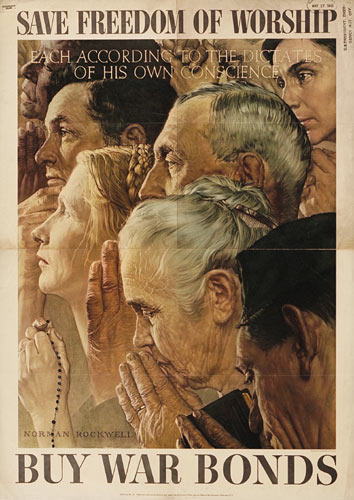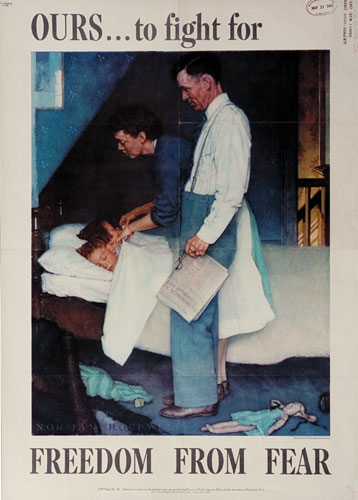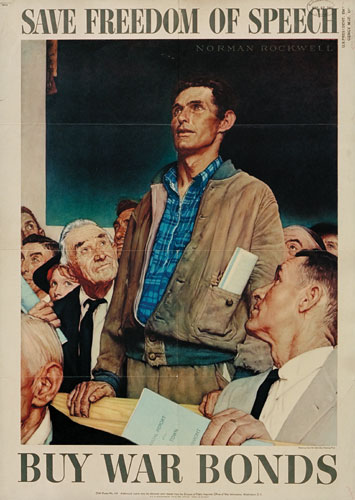Chapter 14 covers a huge section of American history from an economic point of view. However unwise this may be from a learning standpoint, I nonetheless need you to understand the cycles of economic development in our nation’s history. So please go to http://www.thehistorybox.com/ny_city/panics/panics_article1a.htm and read the article.Please take notes or make a chart to have this info in a handy spot in your notebooks, and also bookmark this site for AP review time in April and May.
Archive for the ‘Chapter 33’ Category
1 Mar
Norman Rockwell’s paintings of the Four Freedoms
Read the story behind the paintings here: http://www.americainwwii.com/articles/norman-rockwell-and-the-four-freedoms/
Although Norman Rockwell was not liked very much by the art critics, he was enormously popular. His work was far too sentimental to be critically acclaimed. However, as a draftsman he was quite skilled, and he was very adept at using small details to get his point accross.
The first freedom was the freedom from want. This poster became the most famous and was also known as “The Thanksgiving painting.” Notice how he draws the observer into the painting by having the man in the lower right corner looking back outside the painting at you, thus placing the observer in the family gathered around the table. As a poster (not in the original painting), this painting is being used to encourage enlistment and support of the military.
Another freedom was freedom of worship. Notice the inclusion of the German-looking woman who is obviously Roman Catholic, since she is praying the rosary. This one also includes an African-American.
A third freedom was freedom from fear. Mom and dad tucking the kids into bed– and yes, siblings shared beds and bedrooms all the time in those days, even though this is a two-story house.
And a final freedom was freedom of speech. As the link explained this was based on a real incident at a school board meeting in the town where Rockwell was staying. The man speaking was opposed by almost everyone in the room in what he proposed, but they still respected his right to speak. And class distinction does’t matter– he’s in work clothes, while nearly everyone else is in a suit and tie. Those were the days!
Notice how three of these paintings were turned into posters to encourage buying war bonds.
27 Feb
Route 66
At the top of this page is a drawing of Route 66 with the main towns that lay on the route: http://www.historic66.com/books/map-8statemaps.html
Route 66 now lies alongside Interstate 44 to Oklahoma City and then Interstate 40 to Santa Monica.
The most famous song version is Nat King Cole’s:
And then there’s St. Louis’s own Chuck Berry, for a rock version (he mispronounces Barstow, grrr):
And then it was redone in Cars by John Mayer:
27 Feb
A WPA film: “We Work Again”
What is fascinating is that this was aimed specifically at African Americans and showed how FDR had not forgotten them.
24 Feb
The First Fireside Chat
Read the excerpt from the First Fireside Chat. You can find it on this website: http://historymatters.gmu.edu/d/5199/
Or you can download it as a word document: First Fireside Chat
You can hear a recording of FDR reading most of this excerpt here:
23 Feb
The Bank Run from It’s a Wonderful Life
If you haven’t seen the movie (first of all, shame on you!), George and his family run the Building and Loan in town. It’s like a credit union– the depositors buy shares in the Building and Loan, and then people borrow the money to build their own houses. It’s a tiny, shoestring operation– and independent of the greedy Mr. Potter, who wants to own everything in town.
George (Jimmy Stewart) has just gotten married and is getting ready to go on his honeymoon when a run commences at the bank across the street. Panicked investors then come to his Building and Loan to get their money too. George has to try to get the people to stop panicking and hold steady in the crisis….
21 Feb
Chapter 33 questions
Questions 1-20 are due Monday, February 24! Questions 21-30 are due Tuesday, February 25. You will still have a terms check over the entire chapter on Monday, so make sure you have at least read the chapter carefully.
Chapter 33 questions
ALWAYS INCLUDE DATES AND LEADERS!
1. What was FDR’s background and previous career information? What made him able to connect with the suffering of the common people even though he was wealthy?
2. How did Eleanor help him and influence him? What was her background? Which one of them was more progressive?
3. During the campaign, what did FDR say he would do to combat the Depression? How did this contrast with what Hoover had done, specifically?
4. How did FDR use the time in between the election and his inauguration to his advantage? What did Hoover keep trying to do during this “lame duck” period, and how did FDR respond?
5. Look it up: How was this similar to the lame duck period before Lincoln’s inauguration over the Crittenden Compromise?
6. How did voting patterns change in the election of 1932 and throughout the Roosevelt years, and why? Consider subgroups—women, African Americans, etc.—in your answer. Which groups made up the “New Deal coalition” of voters? What long-term effect did this have on the major parties?
7. What was the relationship like between Congress and FDR upon his taking office in March, 1933? What were the major pieces of legislation passed?
8. What are “the three r’s?” Give an example of a program that accomplished each of the r’s and explain your reasoning.
9. What did the Glass-Steagall Act do, and why? (Also, look it up—what eventually happened to the Glass-Steagall Act, when, and why?)
10. What was the most pressing need for FDR to address upon taking office? How did he specifically address it?
11. Explain this line from FDR’s inaugural address: “The only thing we have to fear is fear itself.” How could that sentiment be applied to the economic situation?
12. Explain the “managed currency” policy. What was the intended result?
13. What were the historical antecedents that influenced New Deal programs (see pp. 828-9)?
14. What was the most popular early New Deal program? Describe it.
15. What was the most ambitious program seeking to help the economy recover? Describe it.
16. What was the most radical New Deal program, accused of introducing “socialism” into the American economy? Describe it, especially which aspect of it was considered to be most controversial.
17. What role did Harry Hopkins play in the New Deal? Include how much money he oversaw.
18. List and summarize the points of the main critics of the New Deal from the right.
19. List and summarize the points of the main critics of the New Deal from the left.
20. Who were Margaret Mead and Ruth Benedict? What field did they specialize in, and what were their main theories?
21. Explain the roles that each of these played in the New Deal: Robert Wagner, Harold Ickes, Frances Perkins, Mary McLeod Bethune, George Norris,
22. Explain the goals and programs of the NRA (not the modern one). Why did it fail?
23. Explain how the Supreme Court resisted early New Deal reforms, including specific cases.
24. What constitutional amendments were added during the New Deal?
25. How did the New Deal attempt to help farmers and sharecroppers? Explain each program and evaluate its effectiveness.
26. What were the causes and effects of the Dust Bowl? What happened to the Okies? Where exactly were they from, where did they go, and why?
27. What dud the Indian Reorganization Act attempt to do? What attitude did John Collier take, and why?
28. What did the Federal Securities Act and the Securities Exchange Commission attempt to do, specifically?
29. Exactly how radical was the New Deal? Why did some people argue that it was actually conservative?
30. Which New Deal programs are still in effect today, and what effect does that have on both what citizens expect from the government and upon the federal budget?
28 Feb
Woody Guthrie– This Land is Your Land
http://www.livinghistoryfarm.org/farminginthe30s/movies/guthrie_life_14.html
Woody Guthrie was a fold singer/songwriter as well as being a union organizer– which affects the interpretation of the entire song.
28 Feb
WPA Slave Narratives from Missouri
During the Great Depression, the WPA hired writers to collect oral histories from former slaves, who by this time ranged in age from their 70s to the 100s. This video is a student project using Slave Narratives that were gathered in from former slaves living in Missouri. Some of the writers wrote down the narratives phonetically based on the pronunciation of the former slave; others were recorded in standard English.
This video can also be accessed at http://www.youtube.com/watch?v=E68yahKvqH0
This is an excellent site to learn more about the Slave Narrative Project, and it contains transcripts of some of the oral histories that were collected: http://xroads.virginia.edu/~hyper/wpa/wpahome.html




You must be logged in to post a comment.